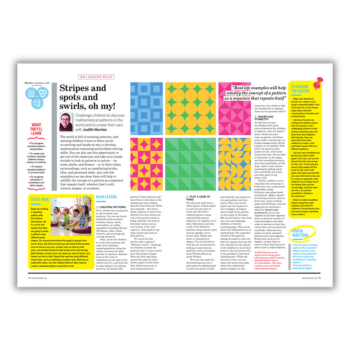Challenge children to discover mathematical patterns in the world and create their own with this repeating patterns KS1 lesson plan…
The world is full of amazing patterns, and opening children’s eyes to them can be an exciting and hands-on way to develop mathematical reasoning and problem-solving skills.
You can also use this opportunity to get out of the classroom and take your pupils outside to look at patterns in nature – on trees, shells, and flowers – or in their urban surroundings, such as tessellating bricks, tiles, and pavement slabs.
Any real-life examples you can show them will help to solidify the concept of a pattern as a sequence that repeats itself, whether that’s with colours, shapes, or numbers.
Learning objectives
- Recognise repeated patterns around us
- Create and continue repeated patterns using a variety of materials
- Explore repeated patterns in art and maths
- Recognise symmetry in snowflakes and other shapes
Starter activity
Begin by creating a repeating pattern with the children themselves. Sit in a circle and explain that they are going to make a pattern using different body shapes.
Go around and number the pupils in groups from one to three. Ask them to stand up and invite all the number ones to hold up one arm, number twos to hold up both arms, and number threes to hold up two arms and one leg.
Alternatively, number ones can stand up, twos sit down, and threes curl up in a ball. Repeat the exercise using different visual clues, such as holding up number cards, Numicon or maths link cubes.
Can the children think of other ways to create a repeated pattern around the circle?
Judith Harries is an experienced early years and primary school teacher, specialising in music, art and drama. She also creates cross-curricular educational content. Download a repeating patterns KS1 worksheet.











